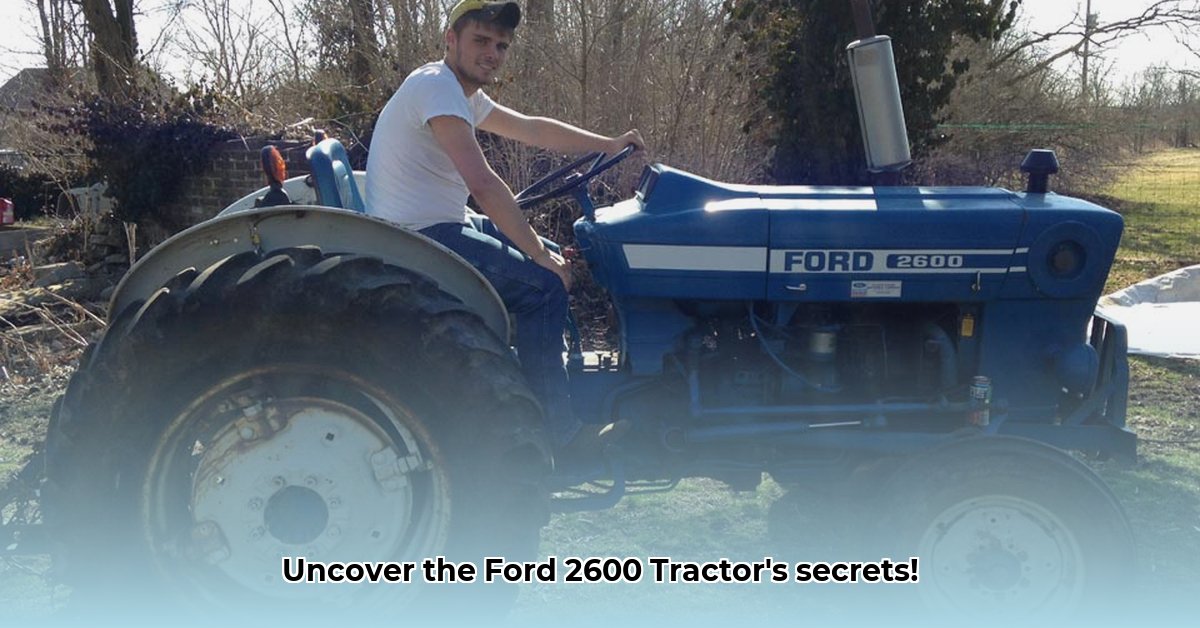
Ford 2600 Tractor: A Deep Dive into Design and Legacy
The Ford 2600 tractor, a stalwart of farms across the nation during the late 1970s and early 1980s, was a reliable workhorse known for its dependability rather than flashy features. This comprehensive guide explores its design, performance, historical context, and lasting impact on the agricultural landscape. For more detailed specifications, check out this detailed guide.
Technical Specifications and Design: Under the Hood
The Ford 2600's core was a 2.6-liter, three-cylinder engine available in gasoline or diesel variants. While horsepower varied slightly based on testing methodology, it consistently delivered around 36 horsepower, sufficient for a wide range of farm tasks. Power transmission relied on a straightforward manual transmission; options included 6-speed, 8-speed, and a convenient 6-speed shuttle shift for efficient directional changes. The hydraulic system, while basic, proved adequate for everyday farm operations. Its simplicity prioritized reliability and ease of maintenance.
Here's a summary of key specifications:
| Feature | Specification | Additional Notes |
|---|---|---|
| Engine | 2.6L, 3-cylinder (Diesel or Gasoline) | Power output varied slightly depending on testing methods |
| Transmission | 6-speed, 8-speed, or 6-speed shuttle shift | All manual transmissions — no electronics! |
| Hydraulic System | Basic, but sufficient for everyday tasks | Simple and reliable, easy to maintain. |
| PTO Power | Approximately 32-36 hp | Output depends on engine condition and load. |
| Weight | Approximately 4,200 lbs | Weight may vary slightly depending on configuration. |
Wasn't the simplicity of the Ford 2600 a key factor in its enduring appeal? How did this design choice affect its long-term success and maintenance costs compared to more complex contemporary tractors?
Farm Performance: Capabilities and Applications
The Ford 2600 wasn't built for massive-scale operations. Instead, it excelled in smaller farm settings, proving versatile for tasks like tilling, hay mowing, and operating balers. Its compact size enhanced maneuverability in confined spaces. Its straightforward design minimized potential points of failure, leading to lower maintenance costs compared to more technologically advanced tractors. While its work rate might seem slower than modern counterparts, its simplicity was a significant selling point for many farmers. The ease of maintenance and repair was a crucial factor in its popularity.
A Tractor's Place in Time: Historical Context and Market Impact
The Ford 2600 debuted in 1975, amidst a period of rapid agricultural mechanization. It effectively filled a niche: a cost-effective, reliable option for smaller farms that didn't demand the power or complexity of larger tractors. Its relatively low price point – approximately $6,436 in 1981 – made it accessible to a broader range of farmers. Although precise sales figures are scarce, the tractor's widespread presence suggests considerable market success. Its affordability likely contributed significantly to its popularity among smaller operations seeking an appropriate balance of capability and cost.
What role did the Ford 2600's competitive pricing play in shaping its market penetration and overall success within the agricultural machinery sector of the late 1970s and early 1980s?
A Lasting Impression: The Ford 2600's Legacy and Modern Relevance
The Ford 2600, despite lacking the sophistication of modern tractors, endures thanks to its robust construction. Many remain operational today, a testament to their build quality. This enduring appeal has also fueled a dedicated enthusiast community focused on restoration and maintenance. While sourcing replacement parts can be challenging, online forums and communities provide invaluable support and resources for owners and restorers alike. The tractor's enduring popularity speaks to the timeless appeal of simplicity and reliability. The relative ease of maintenance compared to more complex modern models might appeal to those who value straightforward repairs.
Restoring a Ford 2600 Tractor: A Step-by-Step Guide
Restoring a Ford 2600 tractor is a rewarding project but requires careful planning and execution. This section outlines a step-by-step approach.
Key Takeaways:
- Prioritize mechanical repairs (clutch, water pump, electrical system) before cosmetic work.
- Use appropriate rust converters (e.g., phosphoric acid-based) for effective metal preparation.
- Source replacement parts (radiator shroud, instrument cluster) early; salvage yards are a valuable resource.
- Consider the pros and cons of painting the engine; prioritize rust prevention.
- Budget carefully; costs can escalate quickly.
Account for unexpected repairs.
Assessment: Complete a thorough inspection, documenting all repairs and parts needed.
- Mechanical Repairs: Address critical mechanical issues (engine, transmission, hydraulics).
- Electrical System: Inspect and repair/replace the wiring and components.
- Bodywork and Paint: Address rust and body damage. Consider whether to paint the engine.
- Reassembly and Testing: Reassemble carefully and thoroughly test all systems.
This methodical approach maximizes efficiency and minimizes potential setbacks during the restoration process. Proper planning and resource allocation are essential for a successful outcome.